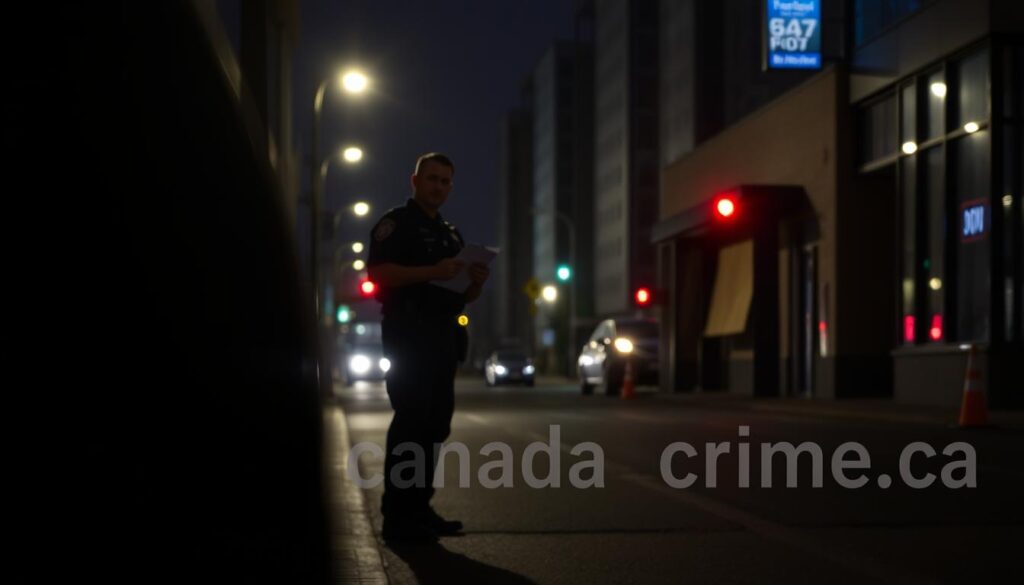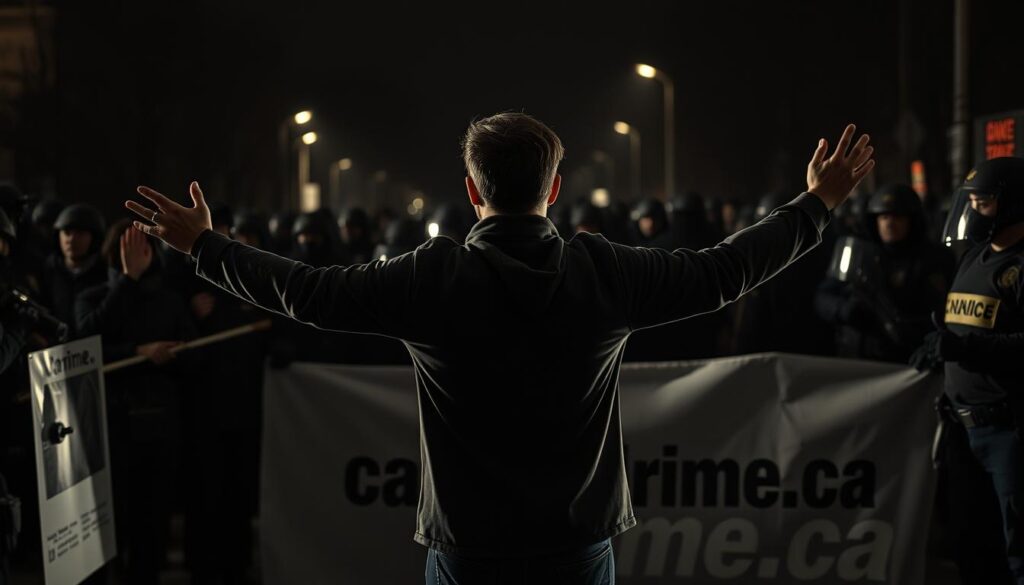Each year, over 94,000 Canadians face charges related to public disturbance. Many are unaware of what this offense means under Canadian law.
Section 175(1) of the Criminal Code defines disturbing the peace. It involves causing a disturbance in or near public places through specific behaviors.
These behaviors include fighting, screaming, shouting, swearing, or using insulting language. Surprisingly, even singing loudly can be an offense.
Public intoxication or impeding others’ movement also falls under this category. Knowing these laws helps you navigate public spaces safely.
This knowledge is crucial for dealing with noisy neighbors or planning events. It’s essential for all Canadians to understand their rights.
Let’s explore the legal framework and potential consequences of disturbing the peace. We’ll also discuss how to protect yourself if faced with such allegations.
Understanding the line between free expression and unlawful disruption is vital. It helps maintain harmony in our communities.
What Constitutes Disturbing the Peace in Canada
Disturbing the peace in Canada covers various disruptive behaviors defined in the Criminal Code. These actions can lead to legal consequences. Knowing these rules helps you respect legal limits in public spaces.
Legal Definition Under the Criminal Code
Canadian law governs disturbing the peace through the Criminal Code. It falls under disorderly conduct, aiming to keep public areas safe and orderly.
This offense targets behaviors that disrupt others’ peaceful enjoyment of public spaces. Unlike civil infractions, it’s a criminal offense that can result in a record.
Section 175 Breakdown and Interpretation
Section 175(1) states that causing a disturbance near a public place is punishable. The law lists several behaviors that count as disturbances:
- Fighting in public places
- Screaming, shouting, or swearing
- Singing in a disruptive manner
- Using insulting or obscene language
- Being intoxicated in public
- Impeding or molesting other persons
These actions must occur outside a dwelling house. Private behavior at home usually doesn’t fall under this law.
Courts look at the context and severity of the disruption. They ask if your actions greatly interfered with normal use of public space.
Historical Development of the Law
The breach of peace concept comes from British common law. It formed the base of Canada’s legal system. These laws aimed to stop public disorder from becoming riots.
Canadian courts have refined Section 175 over time. The 1992 Supreme Court case R. v. Lohnes ruled that noise alone isn’t enough for conviction.
Recent interpretations balance public order with Charter rights. This shows changing views on public behavior while protecting against truly disruptive conduct.
Types of Disruptive Behavior That Can Lead to Charges
Knowing which behaviors might trigger disturbing the peace charges is crucial in Canada. Section 175(1)(a) of the Criminal Code identifies actions considered disruptive enough for legal intervention. These range from physical confrontations to verbal outbursts disturbing public tranquility.
Fighting in Public Places
Public fighting is a common reason for disturbing the peace charges. Physical contact isn’t always necessary for charges to apply. Even threatening gestures or aggressive posturing can constitute an offense.
The law applies to all parties involved in a public altercation. Courts examine whether the behavior reasonably caused fear or disruption to ordinary citizens.
Screaming and Shouting
Vocal disruptions can also lead to charges. Authorities consider volume, content, and context when evaluating shouting as disturbing the peace.
Using profanity or threats in public spaces increases the likelihood of charges. Even non-threatening content at high volume can cross the legal threshold, especially after warnings.
Rowdy Behavior at Events
Public gatherings present challenges for balancing expression with order. Rowdy behavior at events can escalate from enthusiasm to criminal conduct. Authorities must distinguish between natural excitement and genuine public disturbance.
Sports Events and Concerts
Security protocols typically address minor disruptions at sports venues and concerts. However, throwing objects or fighting can result in criminal charges. Many venues have codes of conduct that may lead to ejection and legal consequences.
Public Demonstrations
Demonstrations are complex situations where expression intersects with public order concerns. Canadian law protects peaceful protest. However, property damage or hate speech may lead to charges.
Authorities must prove disruptive behavior substantially interfered with public space use before charges stick. This ensures legitimate protest remains protected while maintaining community safety and access.
Noise Violations as Disturbing the Peace
Excessive noise is a main cause of disturbing the peace charges in Canada. Legal standards determine when sound becomes a violation. Section 175(1)(d) of the Criminal Code prohibits disturbing dwelling-house occupants through disorderly conduct in public places.
Noise violations often sit between criminal offenses and bylaw infractions. “Unreasonable” noise depends on volume, duration, time, and location. A sound okay at noon might be a serious noise violation after midnight.

Loud Music and Party Complaints
Loud music and parties are the most common source of noise-related police calls. When neighbors submit a noise complaint, authorities usually give a warning first. This allows you to reduce volume levels voluntarily.
If police return for repeated complaints, the situation can lead to formal charges. These fall under disturbing the peace provisions.
“Most noise complaints can be resolved without criminal charges if the responsible party cooperates promptly with police instructions to lower volume levels.”
As a host, monitor noise levels and respect your community. Inform neighbors about planned gatherings and keep music at reasonable volumes. As a neighbor, you have the right to peaceful enjoyment of your home.
Construction and Industrial Noise
Construction and industrial activities have different rules than residential noise. Most cities issue permits allowing these operations to make more noise. However, these permissions have limits.
Construction companies must follow set hours and maximum decibel levels. Breaking rules can lead to fines, permit suspensions, or even criminal charges.
Industrial facilities face similar limits, with added environmental rules about noise pollution. The line between allowed noise and disturbance depends on operating within approved limits.
Time-of-Day Considerations
Time is crucial in deciding when noise becomes illegal. Canadian cities set “quiet hours” when noise rules are stricter. Most places follow these general guidelines:
- Weekday quiet hours: 10:00 PM to 7:00 AM
- Weekend quiet hours: 11:00 PM to 9:00 AM
- Holiday quiet hours: Often extended or all-day restrictions
During these times, normal daytime noise can quickly become grounds for a noise complaint. The legal threshold is much lower during quiet hours. This reflects the greater potential for disruption when people are sleeping.
Repeated violations show disregard for community standards and are treated more severely. Courts often see persistent noise offenders as deliberately disturbing the peace.
To avoid charges, learn local noise bylaws and respect quiet hours. Respond quickly to warnings from authorities. If you’re bothered by others’ noise, document incidents and report persistent problems.
Criminal Code vs. Municipal Bylaws
Canada’s legal system handles public disturbances at two levels: federal Criminal Code and local municipal bylaws. This dual approach creates key differences in defining and penalizing disturbing the peace. Understanding these distinctions is vital when facing potential disruptive behavior charges.
When Noise Becomes a Criminal Matter
Noise complaints often start as bylaw infractions. However, certain factors can escalate them to criminal offenses. These include situations that turn ordinary noise into a public nuisance or safety threat.
Criminal Code matters typically involve persistent violations despite warnings. They may also include deliberate disregard for police instructions to stop. Behavior causing harm or threatening others can also lead to criminal charges.

Local Enforcement of Noise Complaints
Canadian cities use various methods to handle noise complaints before they become criminal issues. Most employ a graduated response system. This starts with warnings and can progress to more serious consequences.
The typical process begins with warnings from bylaw officers. It may then move to municipal tickets with fines. Repeated or severe violations can lead to police involvement.
Bylaw officers handle most noise complaints in many areas. Police step in only when the situation goes beyond municipal authority’s ability to resolve.
Jurisdictional Differences Across Canada
Interpretation and enforcement of disturbing the peace laws vary across Canadian regions. Urban centers often have detailed noise bylaws with specific decibel limits. Rural areas typically have less strict regulations.
Provincial laws also affect how cities regulate public disturbances. Ontario’s Municipal Act gives local governments broad powers to create noise bylaws. Quebec’s framework includes civil law aspects that influence disturbing the peace enforcement.
These differences mean that actions might result in warnings in one place but fines elsewhere. When traveling in Canada, familiarize yourself with local rules to avoid breaking unfamiliar bylaws.
Legal Consequences of Disturbing the Peace
Disturbing the peace in Canada can have surprising long-term effects. It’s a summary conviction offense under Section 175 of the Criminal Code. While penalties seem minor, they can impact your life significantly.
Summary Conviction Penalties
Fines for public disturbance range from $500 to $5,000. The severity of your actions and prior convictions affect the fine amount. First-time offenders rarely face jail time, but serious cases may result in up to six months imprisonment.
Courts consider several factors when deciding penalties. These include the nature of disruptive behavior, property damage, and endangerment of others.

Impact on Criminal Record
A disorderly conduct conviction creates a permanent criminal record. It doesn’t disappear automatically after a set period. You must apply for a record suspension to remove it.
The stigma of a criminal record can follow you long after you’ve paid your fine or served your sentence, affecting aspects of life many people take for granted.
Criminal records in Canada are visible to employers, landlords, and border officials. This can create obstacles in various areas of your life.
Employment and Travel Implications
A disturbing the peace conviction can make job searches challenging. Many employers hesitate to hire individuals with criminal records, even for summary offenses.
Border Crossing Issues
Traveling to the United States becomes complicated with a criminal record. U.S. border officials can access Canadian criminal databases. They may deny entry based on your conviction, even for minor offenses.
Professional License Consequences
Criminal convictions can trigger disciplinary proceedings in regulated professions. Many licensing bodies require disclosure of criminal convictions. Some may suspend or revoke licenses based on criminal conduct.
Even without formal licensing, employers often conduct background checks. A conviction could jeopardize your current job or future career opportunities.
Your Legal Rights When Confronted by Police
The Canadian Charter of Rights and Freedoms safeguards citizens during police encounters. These protections ensure fair treatment in disturbing the peace investigations. Understanding your rights is crucial when interacting with law enforcement.
Right to Remain Silent
You don’t have to answer questions beyond basic identification during a disturbing the peace inquiry. You can politely state, “I’ll remain silent until I speak with a lawyer.”
This protects you from making self-incriminating statements. Remember, anything you say could be used against you later.

Right to Legal Representation
You can consult a lawyer before talking to police. If detained, officers must inform you of this right. They should give you a chance to contact legal counsel.
Legal Aid is available if you can’t afford a private attorney. Speaking without a lawyer can harm your defense, even in minor cases.
Protection Against Unreasonable Search and Seizure
The Charter shields you from unjustified searches during disturbing the peace investigations. Police need a warrant, your consent, or arrest-related grounds to search legally.
You can ask, “Am I legally required to consent?” Without proper authority, you may decline the search request.
- A valid search warrant
- Your informed consent
- Reasonable grounds connected to your arrest
Recording Police Interactions
You can usually record police officers on duty in public spaces. This can provide valuable evidence of your interaction. However, there are important limitations to consider.
Don’t interfere with police work or record in private areas. Keep a respectful distance while documenting the encounter. This protects your rights and preserves potential evidence.
The Arrest and Charge Process for Public Disturbance
The arrest process for disturbing the peace in Canada has several key stages. It protects public order and individual rights. Understanding this process can help you make informed decisions if you face such charges.
Disturbing the peace is usually a summary conviction offense. It follows specific steps from arrest through court proceedings.
What to Expect During Arrest
Police respond to public disturbance calls by trying to calm the situation first. They usually give verbal warnings before making an arrest. If disruptive behavior continues, officers may arrest you.
During arrest, police must tell you why and inform you of your right to a lawyer. They can use reasonable force if needed. You have the right to know the reason for your arrest.

Booking and Release Procedures
After arrest, you’ll go to a police station for booking. This process includes recording your info and taking photos and fingerprints. You’ll need to answer basic identification questions truthfully.
For minor disruptive behavior cases, you’ll likely be released soon after booking. Release options typically include:
- An appearance notice issued at the scene
- A promise to appear
- An undertaking with conditions
- A recognizance (rare for minor disturbances)
First Court Appearance
Your first court appearance, called an arraignment, usually happens within a few weeks. The charges are read, and you’ll enter a plea of guilty or not guilty.
This appearance sets the direction for your case. The judge confirms your identity and ensures you understand the charges. The court may provide info about legal aid if you need it.
Bail Considerations
Bail for disturbing the peace charges is usually simple compared to serious offenses. The court looks at your history and the incident when setting release conditions.
Bail conditions might include staying away from the incident location or certain people. Breaking these rules can lead to more charges, so follow them carefully.
Defending Against Disturbing the Peace Charges
Defending against disturbing the peace charges requires specific tactics. A strong defense can challenge the prosecution’s case effectively. With the right strategy, you might see reduced penalties or even case dismissal.
Canadian law offers several ways to counter these allegations. Each approach targets different aspects of the prosecution’s case. Some question evidence reliability, while others assert constitutional rights.
Challenging the Evidence
Scrutinizing prosecution evidence is key in disturbing the peace defenses. Section 175(2) of the Criminal Code allows courts to infer disturbance from officer testimony. This makes challenging officer statements crucial.
Consider these evidence-challenging strategies for your defense:
- Request and review all witness statements for inconsistencies
- Examine police reports for procedural errors or contradictions
- Gather video evidence from security cameras or bystander recordings
- Question the reliability of witness identification, especially in crowded settings
Remember that the prosecution must prove all elements of the offense beyond a reasonable doubt. If they can’t prove your behavior caused a disturbance, their case may fail. This high standard creates many chances to introduce doubt.
“The strength of a disturbing the peace defense often lies not in proving innocence, but in demonstrating that the Crown has failed to meet its burden of proof beyond a reasonable doubt.”
Constitutional Rights Violations
Police misconduct or procedural errors can provide strong defense grounds. Evidence from constitutional violations may be excluded from court. This can significantly weaken the prosecution’s case.
Common constitutional violations in these cases include:
- Arrests made without reasonable grounds
- Denial of your right to legal counsel
- Unlawful searches of your person or property
- Violations of your freedom of expression rights

Your lawyer can file motions to exclude evidence from constitutional violations. In some cases, they may even seek case dismissal. This strategy works best when violations directly impact evidence against you.
Reasonable Explanation Defense
Sometimes, seemingly disruptive behavior has a legitimate explanation. This defense provides context for the alleged disturbance. It helps the court understand the full picture.
Effective reasonable explanations might include:
- Responding to an emergency situation
- Exercising protected free speech rights during a lawful protest
- Participating in culturally significant events with expected noise levels
- Reacting to provocation or harassment from others
Courts often consider context in these cases. If your actions served a legitimate purpose, this defense can be persuasive. It may show your behavior was reasonable under the circumstances.
Necessity and Self-Defense Arguments
Sometimes, disruptive behavior may be justified by immediate threats. The necessity defense argues your actions prevented greater harm. Self-defense applies when responding to safety threats.
To use these defenses successfully, you must show:
- A reasonable belief that danger or harm was imminent
- No reasonable alternative to your actions existed
- The harm you sought to prevent outweighed the disturbance you caused
| Defense Strategy | When Most Effective | Potential Challenges | Success Rate |
|---|---|---|---|
| Challenging Evidence | When witness accounts conflict | Officer testimony given significant weight | Moderate to High |
| Constitutional Violations | Improper police procedures | Proving violation affected case outcome | High when proven |
| Reasonable Explanation | Context justifies behavior | Subjective interpretation by court | Moderate |
| Necessity/Self-Defense | Genuine threat existed | Proving proportional response | Low to Moderate |
Document all aspects of the incident as soon as possible. Collect witness contact info and preserve any recordings. Make detailed notes while your memory is fresh.
Consult a lawyer experienced in these cases to identify the best strategy. Professional help is valuable, even for seemingly minor charges. They can navigate the technical legal aspects effectively.
Disorderly Conduct vs. Breach of Peace
Disorderly conduct and breach of peace have distinct legal meanings in Canada’s criminal justice system. These terms carry different implications that can affect your case’s outcome. Let’s explore their key differences.
Legal Distinctions
Canadian law defines “disturbing the peace” in Section 175 of the Criminal Code. This offense includes fighting, screaming, or causing disturbances in public places.
Breach of peace is rooted in common law. It refers to actions that threaten public tranquility or harm the community. This term covers a wider range of behaviors.
Disorderly conduct is a general term for disruptive behaviors. However, it’s not a specific offense in the Criminal Code.

Charging Decisions by Prosecutors
Prosecutors weigh several factors when choosing charges. These include incident severity, evidence, prior record, and local enforcement priorities.
They may select charges that are easier to prove. Or, they might choose penalties that best fit the situation.
For example, a loud argument in a park could lead to various charges. These might include disturbing the peace, assault, or mischief.
Overlapping Elements
Many public disturbances can fit multiple offenses. Shouting threats in a crowd could be disturbing the peace and uttering threats.
Understanding these overlaps is crucial when working with your lawyer. The specific charge affects penalties, defenses, and long-term consequences.
When considering plea offers, pay attention to the exact offense. The difference between charges can impact your record and future opportunities.
Provincial Variations in Enforcement
Disturbing the peace laws vary across Canada’s provinces and territories. The Criminal Code applies nationwide, but enforcement differs by region. These differences reflect each area’s unique culture, geography, and social characteristics.
Local authorities often create bylaws to address specific community needs. Understanding these regional differences helps navigate public behavior expectations throughout Canada.
Ontario’s Approach
Ontario’s enforcement is influenced by its urban centers. Major cities have detailed noise bylaws working with Criminal Code provisions. These address noise complaints in high-density areas.
The Provincial Offences Act allows authorities to handle minor disturbances without criminal charges. Many noise issues are addressed through municipal enforcement rather than criminal prosecution.
Toronto has specific decibel limits for different areas and times. Stricter regulations apply in residential zones. This recognizes that “disturbing the peace” varies between apartments and suburban neighborhoods.

British Columbia Standards
British Columbia’s approach reflects strong environmental values and quality of life emphasis. The province has provisions for protecting natural soundscapes near parks and protected regions.
Vancouver’s entertainment district has special rules balancing nightlife with residents’ peace. These include zones where higher noise is allowed during specific hours.
BC often uses environmental impact assessments for noise violations, especially near residential areas. This approach is detailed in public order disturbance research.
Quebec’s Legal Framework
Quebec’s civil law tradition influences its approach to disturbing the peace. This creates subtle differences in how behaviors are treated compared to common law provinces.
The province’s approach to demonstrations reflects values about public expression. Montreal has special protocols for managing noise during festivals and events.
Quebec’s noise bylaws often include provisions for cultural activities. These recognize community identity while addressing legitimate noise complaints.
Northern Territories Considerations
In Yukon, Northwest Territories, and Nunavut, enforcement is shaped by sparse population and extreme weather. Indigenous governance systems also play a role.
Vast distances mean longer response times to noise complaints. Traditional Indigenous activities may receive special consideration under local bylaws.
Weather conditions affect enforcement practices. Extreme cold necessitates equipment that might trigger noise concerns. Local authorities exercise greater discretion, considering northern living realities.
Preventing Charges Through Responsible Behavior
Responsible behavior and knowing community rules can help prevent disturbing the peace charges. Understanding legal limits and taking action keeps you law-abiding. It also helps create a more peaceful community environment.
Understanding Local Noise Bylaws
Canadian noise bylaws differ by city. Research your area’s rules before planning noisy activities. These laws usually cover allowed noise levels and quiet hours.
They may have special rules for different zones and event exemptions. Many cities share these laws on their websites or through local offices.
Understanding these regulations before planning activities involving loud music or potential rowdy behavior can save you from unexpected legal complications.
| City | Quiet Hours | Residential Decibel Limit | Complaint Process |
|---|---|---|---|
| Toronto | 11 PM – 7 AM | 50 dB (night) / 55 dB (day) | 311 Service or Online Portal |
| Vancouver | 10 PM – 7 AM | 45 dB (night) / 55 dB (day) | VanConnect App or Phone |
| Montreal | 11 PM – 7 AM | 50 dB (night) / 60 dB (day) | Local Borough Office |
| Calgary | 10 PM – 7 AM | 50 dB (night) / 65 dB (day) | 311 Service |
Proper Event Planning and Notification
Good planning can prevent legal issues when hosting loud or large gatherings. Take these steps to avoid problems:

Tell neighbors about your event, including start and end times. People are more tolerant when informed. For big events, give out written notices with your contact info.
Obtain necessary permitsif your event will:
- Extend beyond normal quiet hours
- Include amplified sound in public spaces
- Involve street closures or public property use
Implement sound management strategies such as:
- Positioning speakers away from neighboring properties
- Using sound barriers or insulation where possible
- Gradually reducing volume as the evening progresses
- Designating quiet areas for guests who need a break
The most common disturbing the peace charges I see could have been easily avoided with simple communication. When neighbors know what to expect and when the noise will end, they’re far less likely to call authorities.
De-escalation Techniques in Public Disputes
Learning to calm conflicts can prevent minor issues from becoming legal problems. Here are some effective techniques:
Controlling your emotional responseis crucial when tensions rise. Breathe deeply and speak calmly, even if others are loud. This approach often prevents rowdy behavior.
Create physical distance when possible. Stepping back a few feet can reduce tension and give everyone space to calm down.
Use non-confrontational body language. Keep hands visible, maintain a relaxed posture, and avoid aggressive gestures. Your body language speaks as loud as words.
Practice active listeningby acknowledging concerns without agreeing. Phrases like “I understand you’re frustrated” can help defuse tense situations.
Know when to walk away. Sometimes, leaving a volatile situation is the best choice to avoid legal trouble.
Working with Authorities Proactively
Building good relationships with local authorities can help handle potential disturbances better. Try these proactive approaches:
For planned events, ask police or bylaw officers about security and noise management. Many departments offer guidance to ensure compliance with local rules.
Learn the proper ways to address noise complaints in your area. Respond respectfully to neighbor concerns and take quick action to prevent formal complaints.
Join community policing groups or neighborhood associations. These connections can help if misunderstandings occur with law enforcement.
When authorities do respond to complaints, stay calm and cooperative. Hostile reactions can turn a warning into serious legal trouble.
Conclusion
Grasping Canada’s disturbing the peace laws is vital for protecting your rights and respecting public order. The Criminal Code Section 175 provides the legal framework. However, interpretation varies across provinces and municipalities.
Knowing your legal rights can greatly impact the outcome of a public nuisance complaint. If approached by law enforcement, exercise your right to remain silent and seek legal representation immediately.
A disturbing the peace conviction has far-reaching consequences beyond immediate penalties. It creates a criminal record that can affect your job prospects, travel abilities, and community standing.
Local bylaws often complement federal regulations, creating a complex legal landscape. Acceptable noise levels in downtown Toronto might be considered disturbing in a quiet Vancouver suburb.
Your best defense is taking preventative steps. Learn local noise rules and practice conflict de-escalation techniques. Communicate with neighbors before hosting potentially noisy events.
Canadian law balances individual freedoms with community well-being. Understanding your rights and responsibilities helps you navigate public spaces confidently and avoid legal troubles.

